Strategic Information Systems Report: M&S Competitive Advantage
VerifiedAdded on 2020/06/04
|10
|3457
|265
Report
AI Summary
This report analyzes the strategic information systems of Marks & Spencer (M&S), focusing on their current processes, challenges, and strategies for gaining a competitive advantage. It explores the use of PEST analysis, the importance of information system strategies, and the benefits of implementing such systems. The report examines M&S's use of technology, including transaction processing systems and customer relationship management, and identifies issues like low productivity and inadequate alignment of information systems with business needs. It also discusses how M&S can overcome difficulties in developing an information systems strategy, such as high time intensity and investment costs, by preparing timelines, communicating benefits to employees, and utilizing budgeting tools. The report concludes with a discussion of typical problems in information system projects, offering potential solutions to improve M&S's business operations and ensure success in the competitive retail market. The report also covers the significance of Information Systems (IS) Strategy and the benefits of having one in the organization.
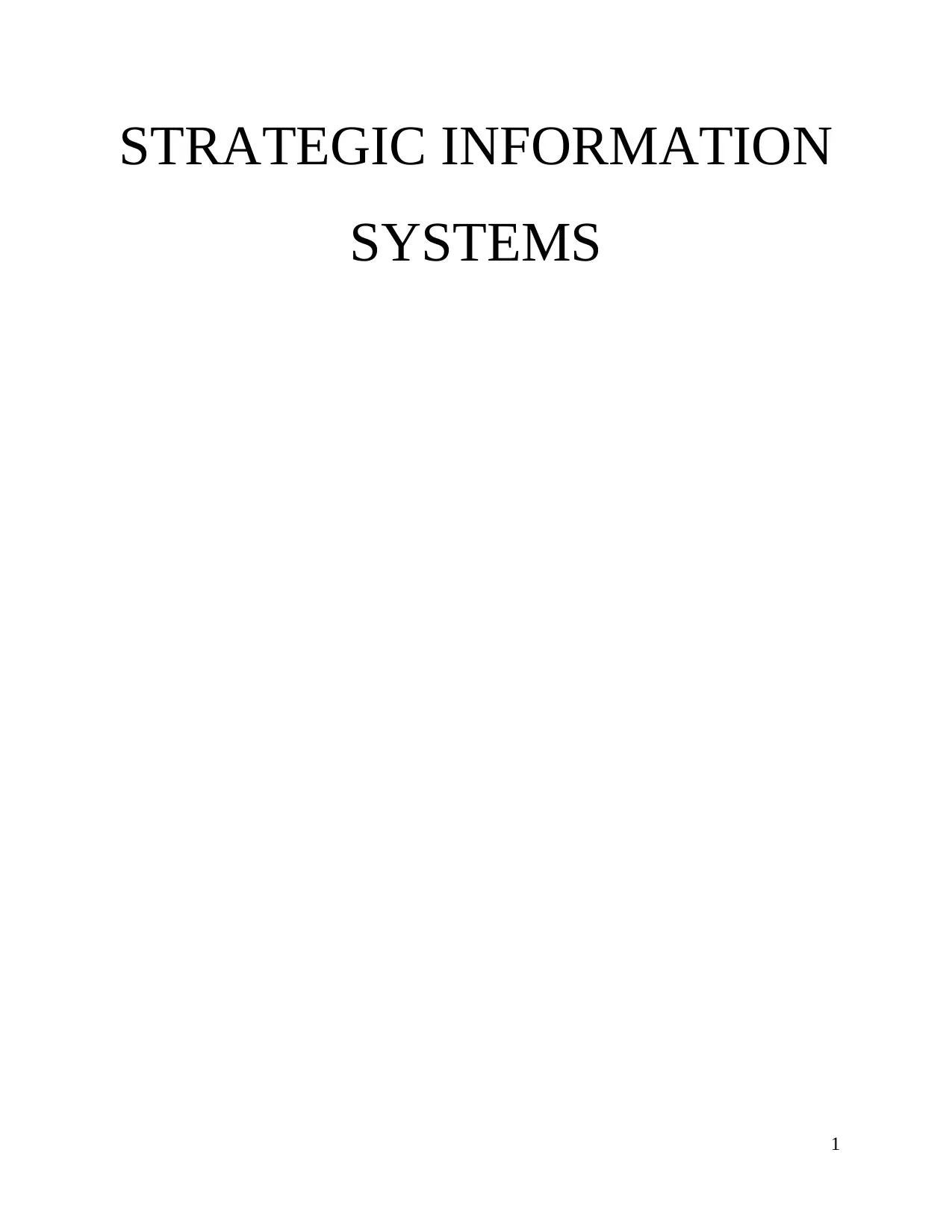
STRATEGIC INFORMATION
SYSTEMS
1
SYSTEMS
1
Paraphrase This Document
Need a fresh take? Get an instant paraphrase of this document with our AI Paraphraser
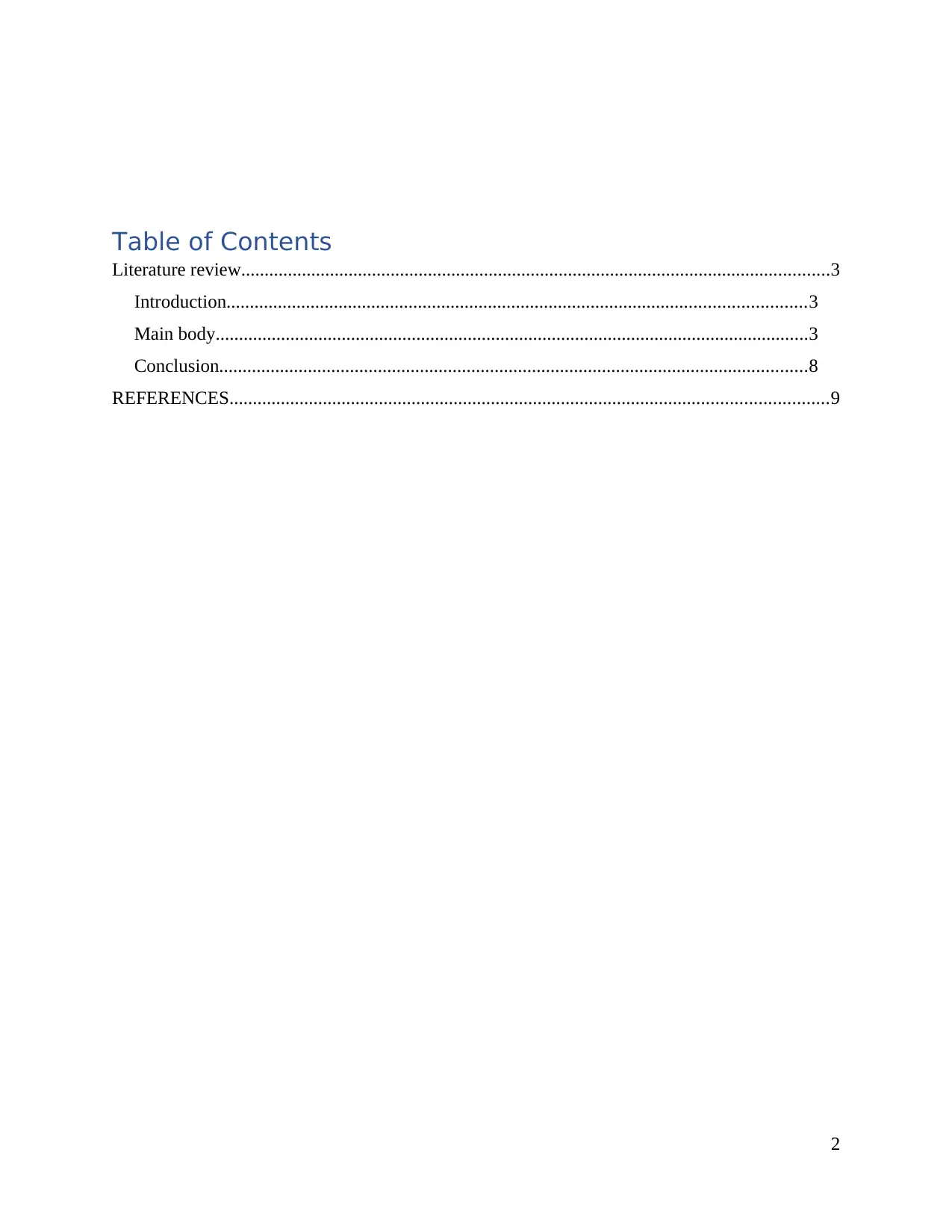
Table of Contents
Literature review..............................................................................................................................3
Introduction............................................................................................................................3
Main body...............................................................................................................................3
Conclusion..............................................................................................................................8
REFERENCES................................................................................................................................9
2
Literature review..............................................................................................................................3
Introduction............................................................................................................................3
Main body...............................................................................................................................3
Conclusion..............................................................................................................................8
REFERENCES................................................................................................................................9
2
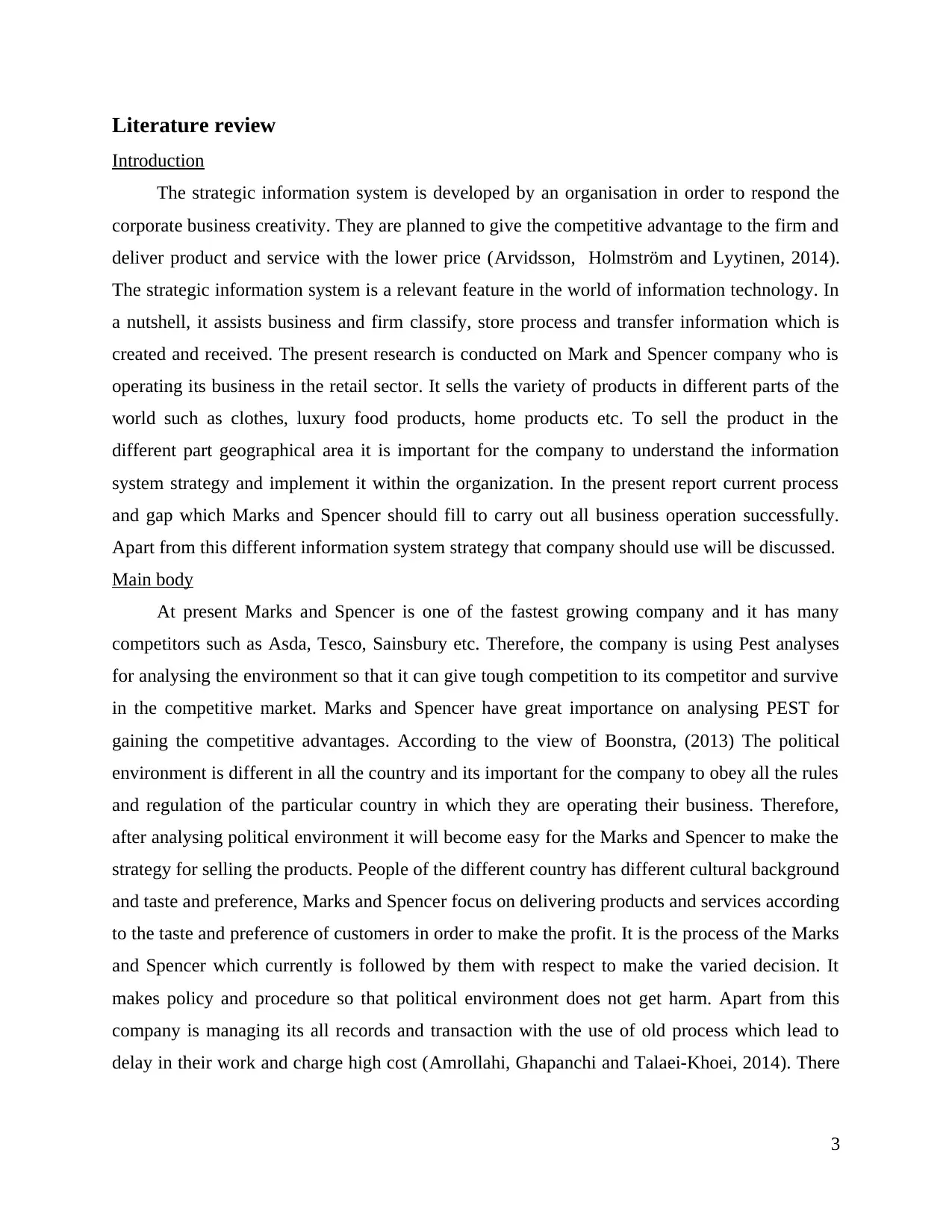
Literature review
Introduction
The strategic information system is developed by an organisation in order to respond the
corporate business creativity. They are planned to give the competitive advantage to the firm and
deliver product and service with the lower price (Arvidsson, Holmström and Lyytinen, 2014).
The strategic information system is a relevant feature in the world of information technology. In
a nutshell, it assists business and firm classify, store process and transfer information which is
created and received. The present research is conducted on Mark and Spencer company who is
operating its business in the retail sector. It sells the variety of products in different parts of the
world such as clothes, luxury food products, home products etc. To sell the product in the
different part geographical area it is important for the company to understand the information
system strategy and implement it within the organization. In the present report current process
and gap which Marks and Spencer should fill to carry out all business operation successfully.
Apart from this different information system strategy that company should use will be discussed.
Main body
At present Marks and Spencer is one of the fastest growing company and it has many
competitors such as Asda, Tesco, Sainsbury etc. Therefore, the company is using Pest analyses
for analysing the environment so that it can give tough competition to its competitor and survive
in the competitive market. Marks and Spencer have great importance on analysing PEST for
gaining the competitive advantages. According to the view of Boonstra, (2013) The political
environment is different in all the country and its important for the company to obey all the rules
and regulation of the particular country in which they are operating their business. Therefore,
after analysing political environment it will become easy for the Marks and Spencer to make the
strategy for selling the products. People of the different country has different cultural background
and taste and preference, Marks and Spencer focus on delivering products and services according
to the taste and preference of customers in order to make the profit. It is the process of the Marks
and Spencer which currently is followed by them with respect to make the varied decision. It
makes policy and procedure so that political environment does not get harm. Apart from this
company is managing its all records and transaction with the use of old process which lead to
delay in their work and charge high cost (Amrollahi, Ghapanchi and Talaei-Khoei, 2014). There
3
Introduction
The strategic information system is developed by an organisation in order to respond the
corporate business creativity. They are planned to give the competitive advantage to the firm and
deliver product and service with the lower price (Arvidsson, Holmström and Lyytinen, 2014).
The strategic information system is a relevant feature in the world of information technology. In
a nutshell, it assists business and firm classify, store process and transfer information which is
created and received. The present research is conducted on Mark and Spencer company who is
operating its business in the retail sector. It sells the variety of products in different parts of the
world such as clothes, luxury food products, home products etc. To sell the product in the
different part geographical area it is important for the company to understand the information
system strategy and implement it within the organization. In the present report current process
and gap which Marks and Spencer should fill to carry out all business operation successfully.
Apart from this different information system strategy that company should use will be discussed.
Main body
At present Marks and Spencer is one of the fastest growing company and it has many
competitors such as Asda, Tesco, Sainsbury etc. Therefore, the company is using Pest analyses
for analysing the environment so that it can give tough competition to its competitor and survive
in the competitive market. Marks and Spencer have great importance on analysing PEST for
gaining the competitive advantages. According to the view of Boonstra, (2013) The political
environment is different in all the country and its important for the company to obey all the rules
and regulation of the particular country in which they are operating their business. Therefore,
after analysing political environment it will become easy for the Marks and Spencer to make the
strategy for selling the products. People of the different country has different cultural background
and taste and preference, Marks and Spencer focus on delivering products and services according
to the taste and preference of customers in order to make the profit. It is the process of the Marks
and Spencer which currently is followed by them with respect to make the varied decision. It
makes policy and procedure so that political environment does not get harm. Apart from this
company is managing its all records and transaction with the use of old process which lead to
delay in their work and charge high cost (Amrollahi, Ghapanchi and Talaei-Khoei, 2014). There
3
⊘ This is a preview!⊘
Do you want full access?
Subscribe today to unlock all pages.

Trusted by 1+ million students worldwide
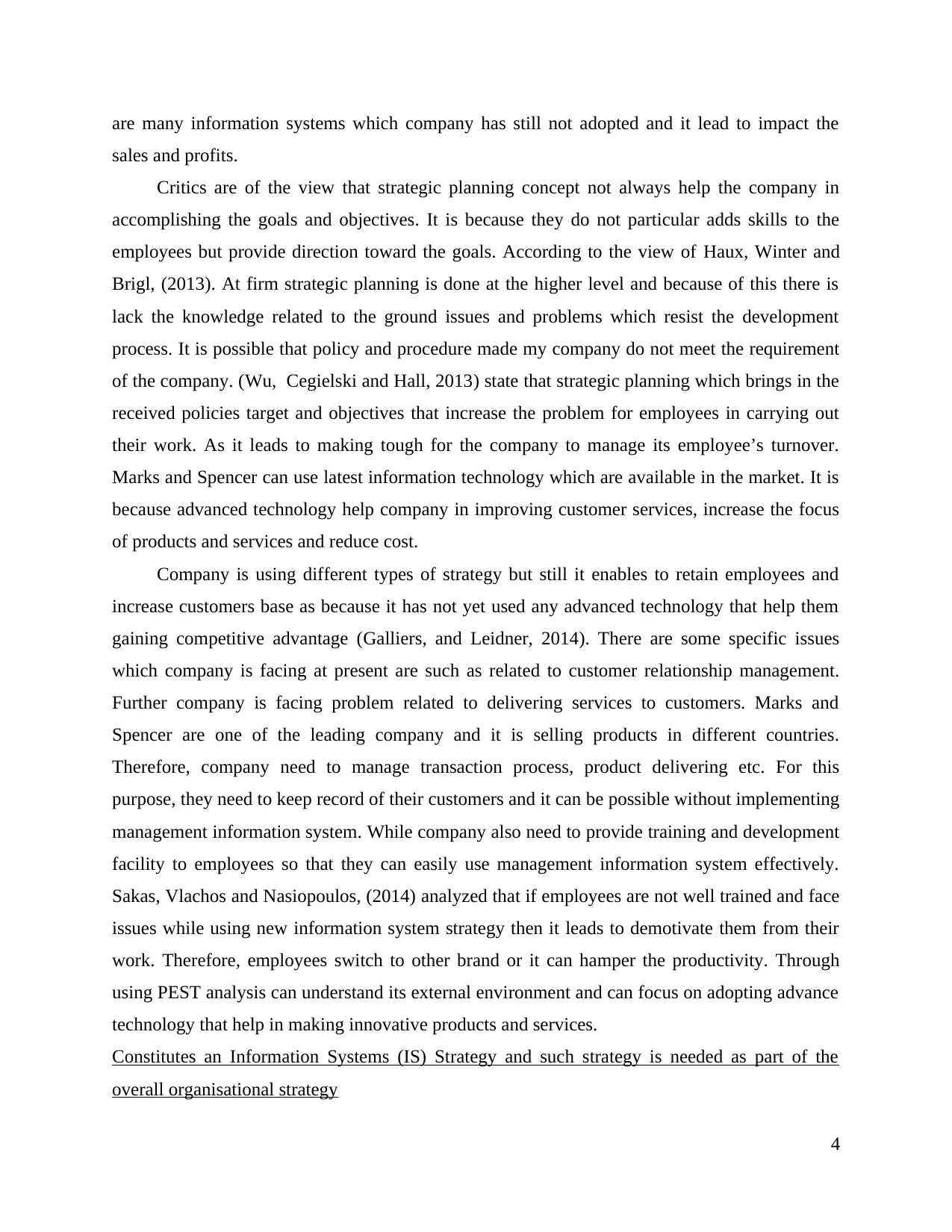
are many information systems which company has still not adopted and it lead to impact the
sales and profits.
Critics are of the view that strategic planning concept not always help the company in
accomplishing the goals and objectives. It is because they do not particular adds skills to the
employees but provide direction toward the goals. According to the view of Haux, Winter and
Brigl, (2013). At firm strategic planning is done at the higher level and because of this there is
lack the knowledge related to the ground issues and problems which resist the development
process. It is possible that policy and procedure made my company do not meet the requirement
of the company. (Wu, Cegielski and Hall, 2013) state that strategic planning which brings in the
received policies target and objectives that increase the problem for employees in carrying out
their work. As it leads to making tough for the company to manage its employee’s turnover.
Marks and Spencer can use latest information technology which are available in the market. It is
because advanced technology help company in improving customer services, increase the focus
of products and services and reduce cost.
Company is using different types of strategy but still it enables to retain employees and
increase customers base as because it has not yet used any advanced technology that help them
gaining competitive advantage (Galliers, and Leidner, 2014). There are some specific issues
which company is facing at present are such as related to customer relationship management.
Further company is facing problem related to delivering services to customers. Marks and
Spencer are one of the leading company and it is selling products in different countries.
Therefore, company need to manage transaction process, product delivering etc. For this
purpose, they need to keep record of their customers and it can be possible without implementing
management information system. While company also need to provide training and development
facility to employees so that they can easily use management information system effectively.
Sakas, Vlachos and Nasiopoulos, (2014) analyzed that if employees are not well trained and face
issues while using new information system strategy then it leads to demotivate them from their
work. Therefore, employees switch to other brand or it can hamper the productivity. Through
using PEST analysis can understand its external environment and can focus on adopting advance
technology that help in making innovative products and services.
Constitutes an Information Systems (IS) Strategy and such strategy is needed as part of the
overall organisational strategy
4
sales and profits.
Critics are of the view that strategic planning concept not always help the company in
accomplishing the goals and objectives. It is because they do not particular adds skills to the
employees but provide direction toward the goals. According to the view of Haux, Winter and
Brigl, (2013). At firm strategic planning is done at the higher level and because of this there is
lack the knowledge related to the ground issues and problems which resist the development
process. It is possible that policy and procedure made my company do not meet the requirement
of the company. (Wu, Cegielski and Hall, 2013) state that strategic planning which brings in the
received policies target and objectives that increase the problem for employees in carrying out
their work. As it leads to making tough for the company to manage its employee’s turnover.
Marks and Spencer can use latest information technology which are available in the market. It is
because advanced technology help company in improving customer services, increase the focus
of products and services and reduce cost.
Company is using different types of strategy but still it enables to retain employees and
increase customers base as because it has not yet used any advanced technology that help them
gaining competitive advantage (Galliers, and Leidner, 2014). There are some specific issues
which company is facing at present are such as related to customer relationship management.
Further company is facing problem related to delivering services to customers. Marks and
Spencer are one of the leading company and it is selling products in different countries.
Therefore, company need to manage transaction process, product delivering etc. For this
purpose, they need to keep record of their customers and it can be possible without implementing
management information system. While company also need to provide training and development
facility to employees so that they can easily use management information system effectively.
Sakas, Vlachos and Nasiopoulos, (2014) analyzed that if employees are not well trained and face
issues while using new information system strategy then it leads to demotivate them from their
work. Therefore, employees switch to other brand or it can hamper the productivity. Through
using PEST analysis can understand its external environment and can focus on adopting advance
technology that help in making innovative products and services.
Constitutes an Information Systems (IS) Strategy and such strategy is needed as part of the
overall organisational strategy
4
Paraphrase This Document
Need a fresh take? Get an instant paraphrase of this document with our AI Paraphraser
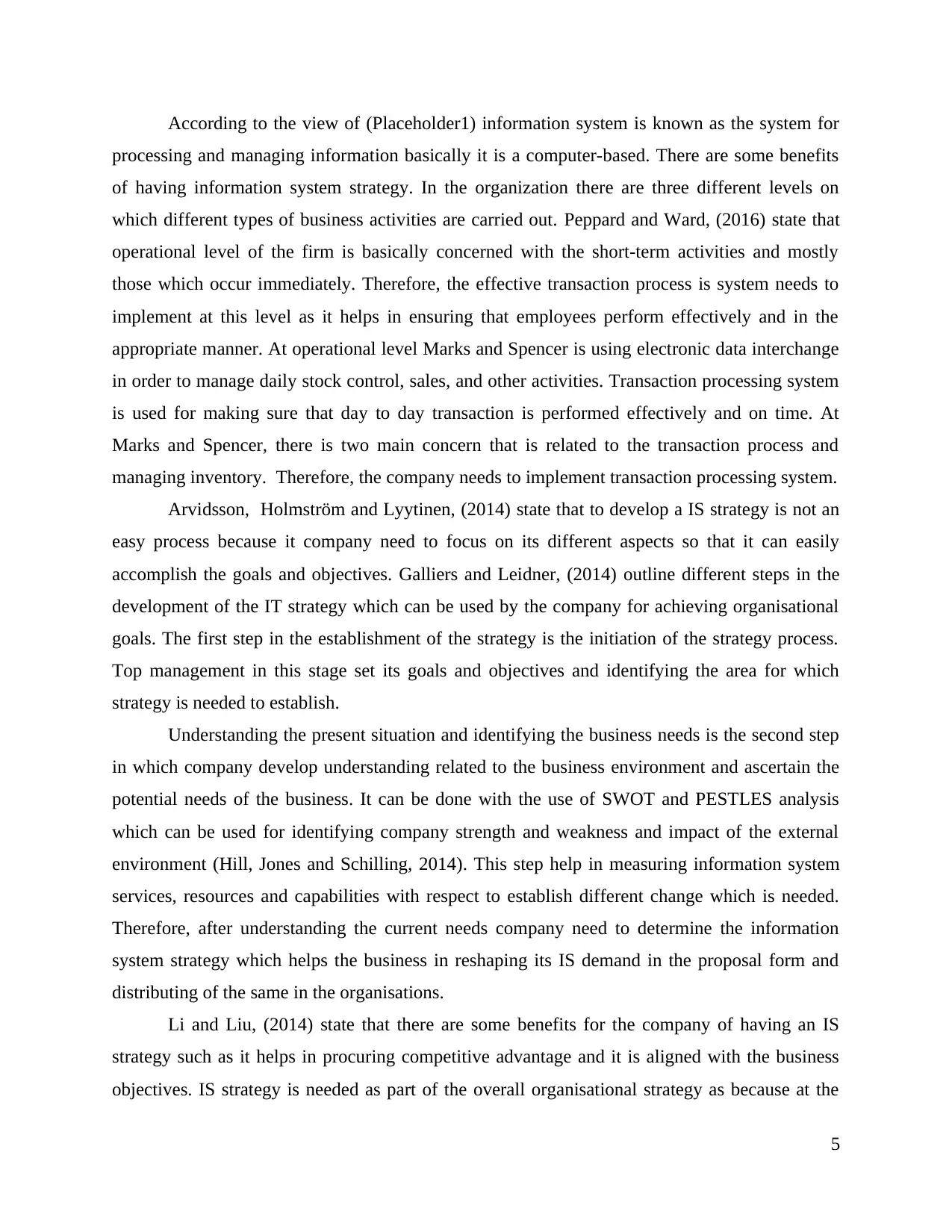
According to the view of (Placeholder1) information system is known as the system for
processing and managing information basically it is a computer-based. There are some benefits
of having information system strategy. In the organization there are three different levels on
which different types of business activities are carried out. Peppard and Ward, (2016) state that
operational level of the firm is basically concerned with the short-term activities and mostly
those which occur immediately. Therefore, the effective transaction process is system needs to
implement at this level as it helps in ensuring that employees perform effectively and in the
appropriate manner. At operational level Marks and Spencer is using electronic data interchange
in order to manage daily stock control, sales, and other activities. Transaction processing system
is used for making sure that day to day transaction is performed effectively and on time. At
Marks and Spencer, there is two main concern that is related to the transaction process and
managing inventory. Therefore, the company needs to implement transaction processing system.
Arvidsson, Holmström and Lyytinen, (2014) state that to develop a IS strategy is not an
easy process because it company need to focus on its different aspects so that it can easily
accomplish the goals and objectives. Galliers and Leidner, (2014) outline different steps in the
development of the IT strategy which can be used by the company for achieving organisational
goals. The first step in the establishment of the strategy is the initiation of the strategy process.
Top management in this stage set its goals and objectives and identifying the area for which
strategy is needed to establish.
Understanding the present situation and identifying the business needs is the second step
in which company develop understanding related to the business environment and ascertain the
potential needs of the business. It can be done with the use of SWOT and PESTLES analysis
which can be used for identifying company strength and weakness and impact of the external
environment (Hill, Jones and Schilling, 2014). This step help in measuring information system
services, resources and capabilities with respect to establish different change which is needed.
Therefore, after understanding the current needs company need to determine the information
system strategy which helps the business in reshaping its IS demand in the proposal form and
distributing of the same in the organisations.
Li and Liu, (2014) state that there are some benefits for the company of having an IS
strategy such as it helps in procuring competitive advantage and it is aligned with the business
objectives. IS strategy is needed as part of the overall organisational strategy as because at the
5
processing and managing information basically it is a computer-based. There are some benefits
of having information system strategy. In the organization there are three different levels on
which different types of business activities are carried out. Peppard and Ward, (2016) state that
operational level of the firm is basically concerned with the short-term activities and mostly
those which occur immediately. Therefore, the effective transaction process is system needs to
implement at this level as it helps in ensuring that employees perform effectively and in the
appropriate manner. At operational level Marks and Spencer is using electronic data interchange
in order to manage daily stock control, sales, and other activities. Transaction processing system
is used for making sure that day to day transaction is performed effectively and on time. At
Marks and Spencer, there is two main concern that is related to the transaction process and
managing inventory. Therefore, the company needs to implement transaction processing system.
Arvidsson, Holmström and Lyytinen, (2014) state that to develop a IS strategy is not an
easy process because it company need to focus on its different aspects so that it can easily
accomplish the goals and objectives. Galliers and Leidner, (2014) outline different steps in the
development of the IT strategy which can be used by the company for achieving organisational
goals. The first step in the establishment of the strategy is the initiation of the strategy process.
Top management in this stage set its goals and objectives and identifying the area for which
strategy is needed to establish.
Understanding the present situation and identifying the business needs is the second step
in which company develop understanding related to the business environment and ascertain the
potential needs of the business. It can be done with the use of SWOT and PESTLES analysis
which can be used for identifying company strength and weakness and impact of the external
environment (Hill, Jones and Schilling, 2014). This step help in measuring information system
services, resources and capabilities with respect to establish different change which is needed.
Therefore, after understanding the current needs company need to determine the information
system strategy which helps the business in reshaping its IS demand in the proposal form and
distributing of the same in the organisations.
Li and Liu, (2014) state that there are some benefits for the company of having an IS
strategy such as it helps in procuring competitive advantage and it is aligned with the business
objectives. IS strategy is needed as part of the overall organisational strategy as because at the
5
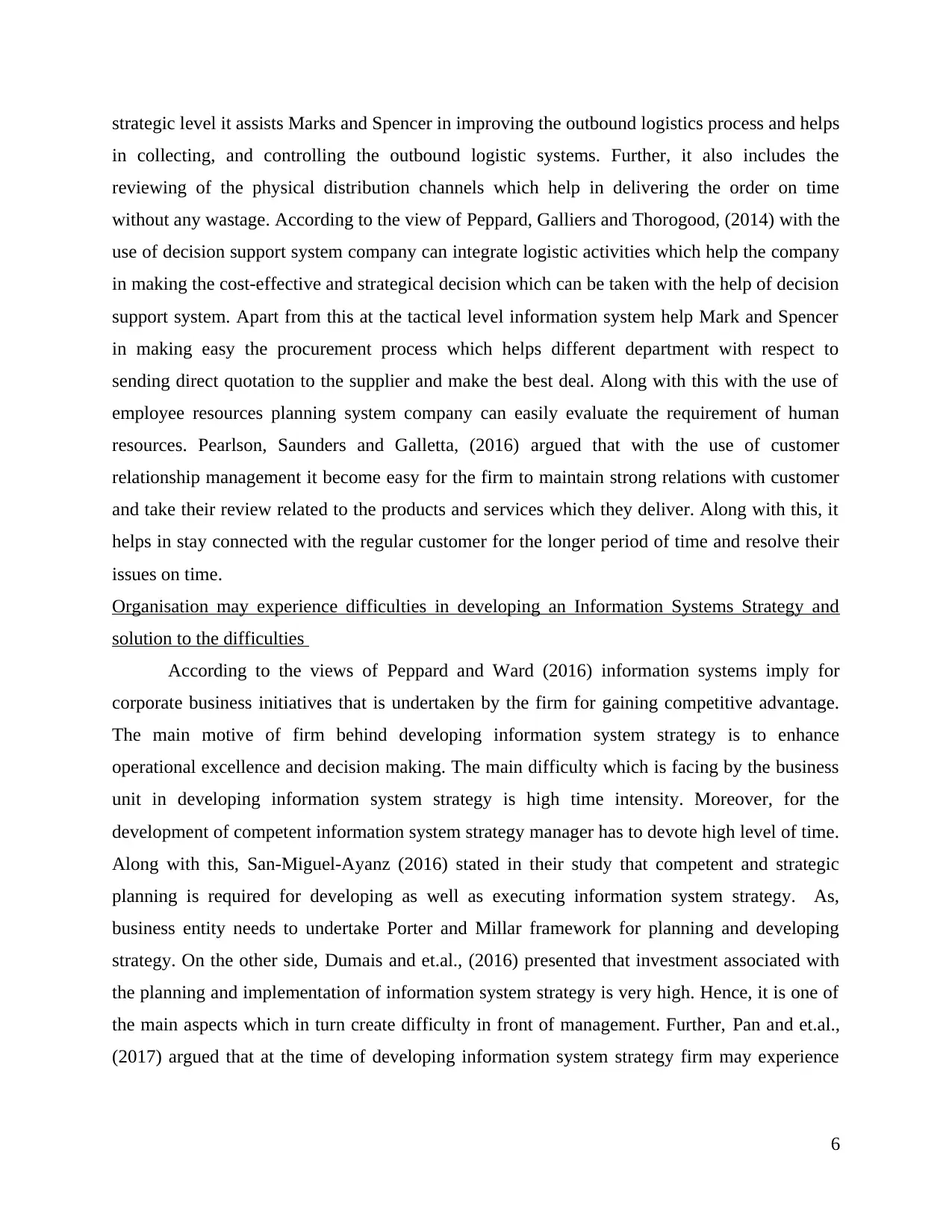
strategic level it assists Marks and Spencer in improving the outbound logistics process and helps
in collecting, and controlling the outbound logistic systems. Further, it also includes the
reviewing of the physical distribution channels which help in delivering the order on time
without any wastage. According to the view of Peppard, Galliers and Thorogood, (2014) with the
use of decision support system company can integrate logistic activities which help the company
in making the cost-effective and strategical decision which can be taken with the help of decision
support system. Apart from this at the tactical level information system help Mark and Spencer
in making easy the procurement process which helps different department with respect to
sending direct quotation to the supplier and make the best deal. Along with this with the use of
employee resources planning system company can easily evaluate the requirement of human
resources. Pearlson, Saunders and Galletta, (2016) argued that with the use of customer
relationship management it become easy for the firm to maintain strong relations with customer
and take their review related to the products and services which they deliver. Along with this, it
helps in stay connected with the regular customer for the longer period of time and resolve their
issues on time.
Organisation may experience difficulties in developing an Information Systems Strategy and
solution to the difficulties
According to the views of Peppard and Ward (2016) information systems imply for
corporate business initiatives that is undertaken by the firm for gaining competitive advantage.
The main motive of firm behind developing information system strategy is to enhance
operational excellence and decision making. The main difficulty which is facing by the business
unit in developing information system strategy is high time intensity. Moreover, for the
development of competent information system strategy manager has to devote high level of time.
Along with this, San-Miguel-Ayanz (2016) stated in their study that competent and strategic
planning is required for developing as well as executing information system strategy. As,
business entity needs to undertake Porter and Millar framework for planning and developing
strategy. On the other side, Dumais and et.al., (2016) presented that investment associated with
the planning and implementation of information system strategy is very high. Hence, it is one of
the main aspects which in turn create difficulty in front of management. Further, Pan and et.al.,
(2017) argued that at the time of developing information system strategy firm may experience
6
in collecting, and controlling the outbound logistic systems. Further, it also includes the
reviewing of the physical distribution channels which help in delivering the order on time
without any wastage. According to the view of Peppard, Galliers and Thorogood, (2014) with the
use of decision support system company can integrate logistic activities which help the company
in making the cost-effective and strategical decision which can be taken with the help of decision
support system. Apart from this at the tactical level information system help Mark and Spencer
in making easy the procurement process which helps different department with respect to
sending direct quotation to the supplier and make the best deal. Along with this with the use of
employee resources planning system company can easily evaluate the requirement of human
resources. Pearlson, Saunders and Galletta, (2016) argued that with the use of customer
relationship management it become easy for the firm to maintain strong relations with customer
and take their review related to the products and services which they deliver. Along with this, it
helps in stay connected with the regular customer for the longer period of time and resolve their
issues on time.
Organisation may experience difficulties in developing an Information Systems Strategy and
solution to the difficulties
According to the views of Peppard and Ward (2016) information systems imply for
corporate business initiatives that is undertaken by the firm for gaining competitive advantage.
The main motive of firm behind developing information system strategy is to enhance
operational excellence and decision making. The main difficulty which is facing by the business
unit in developing information system strategy is high time intensity. Moreover, for the
development of competent information system strategy manager has to devote high level of time.
Along with this, San-Miguel-Ayanz (2016) stated in their study that competent and strategic
planning is required for developing as well as executing information system strategy. As,
business entity needs to undertake Porter and Millar framework for planning and developing
strategy. On the other side, Dumais and et.al., (2016) presented that investment associated with
the planning and implementation of information system strategy is very high. Hence, it is one of
the main aspects which in turn create difficulty in front of management. Further, Pan and et.al.,
(2017) argued that at the time of developing information system strategy firm may experience
6
⊘ This is a preview!⊘
Do you want full access?
Subscribe today to unlock all pages.

Trusted by 1+ million students worldwide
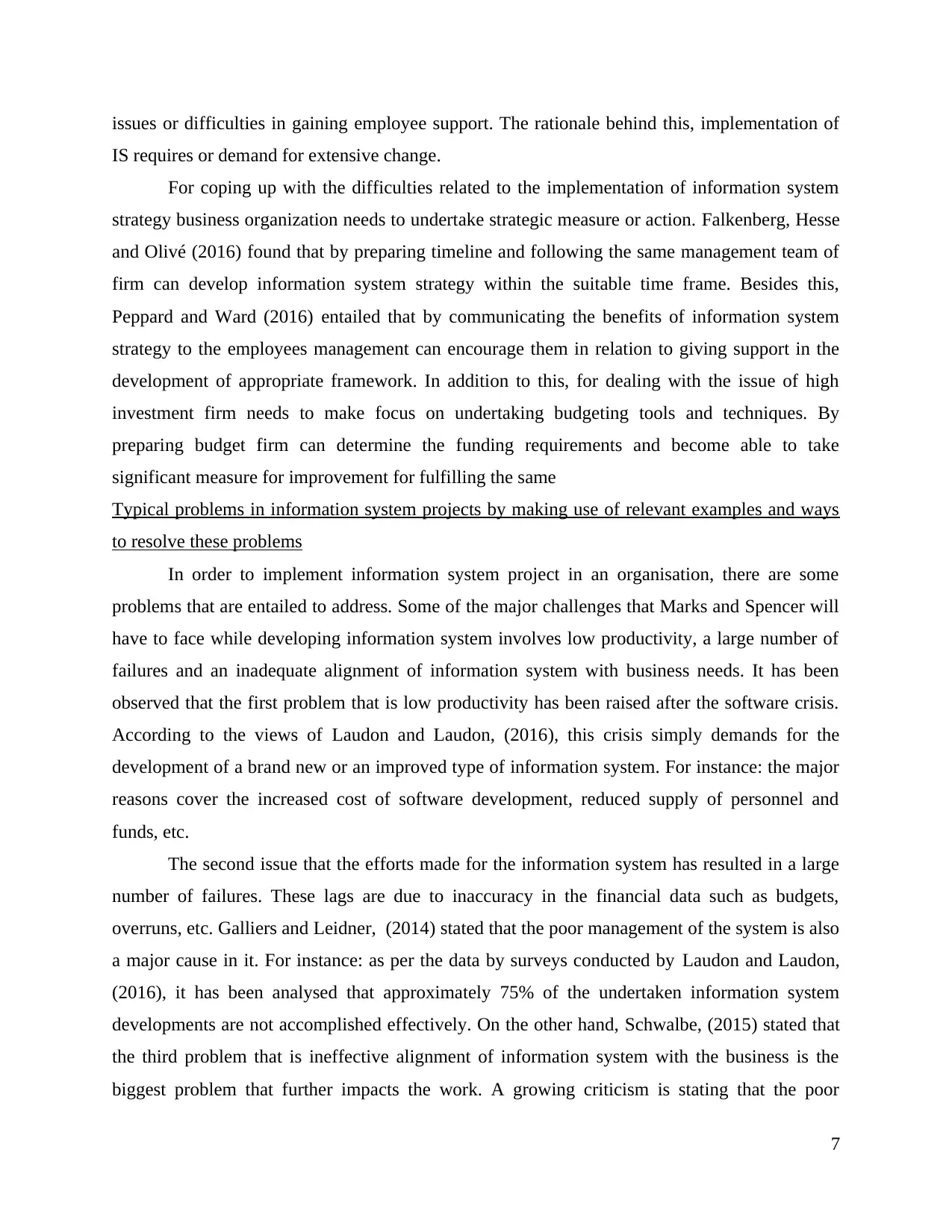
issues or difficulties in gaining employee support. The rationale behind this, implementation of
IS requires or demand for extensive change.
For coping up with the difficulties related to the implementation of information system
strategy business organization needs to undertake strategic measure or action. Falkenberg, Hesse
and Olivé (2016) found that by preparing timeline and following the same management team of
firm can develop information system strategy within the suitable time frame. Besides this,
Peppard and Ward (2016) entailed that by communicating the benefits of information system
strategy to the employees management can encourage them in relation to giving support in the
development of appropriate framework. In addition to this, for dealing with the issue of high
investment firm needs to make focus on undertaking budgeting tools and techniques. By
preparing budget firm can determine the funding requirements and become able to take
significant measure for improvement for fulfilling the same
Typical problems in information system projects by making use of relevant examples and ways
to resolve these problems
In order to implement information system project in an organisation, there are some
problems that are entailed to address. Some of the major challenges that Marks and Spencer will
have to face while developing information system involves low productivity, a large number of
failures and an inadequate alignment of information system with business needs. It has been
observed that the first problem that is low productivity has been raised after the software crisis.
According to the views of Laudon and Laudon, (2016), this crisis simply demands for the
development of a brand new or an improved type of information system. For instance: the major
reasons cover the increased cost of software development, reduced supply of personnel and
funds, etc.
The second issue that the efforts made for the information system has resulted in a large
number of failures. These lags are due to inaccuracy in the financial data such as budgets,
overruns, etc. Galliers and Leidner, (2014) stated that the poor management of the system is also
a major cause in it. For instance: as per the data by surveys conducted by Laudon and Laudon,
(2016), it has been analysed that approximately 75% of the undertaken information system
developments are not accomplished effectively. On the other hand, Schwalbe, (2015) stated that
the third problem that is ineffective alignment of information system with the business is the
biggest problem that further impacts the work. A growing criticism is stating that the poor
7
IS requires or demand for extensive change.
For coping up with the difficulties related to the implementation of information system
strategy business organization needs to undertake strategic measure or action. Falkenberg, Hesse
and Olivé (2016) found that by preparing timeline and following the same management team of
firm can develop information system strategy within the suitable time frame. Besides this,
Peppard and Ward (2016) entailed that by communicating the benefits of information system
strategy to the employees management can encourage them in relation to giving support in the
development of appropriate framework. In addition to this, for dealing with the issue of high
investment firm needs to make focus on undertaking budgeting tools and techniques. By
preparing budget firm can determine the funding requirements and become able to take
significant measure for improvement for fulfilling the same
Typical problems in information system projects by making use of relevant examples and ways
to resolve these problems
In order to implement information system project in an organisation, there are some
problems that are entailed to address. Some of the major challenges that Marks and Spencer will
have to face while developing information system involves low productivity, a large number of
failures and an inadequate alignment of information system with business needs. It has been
observed that the first problem that is low productivity has been raised after the software crisis.
According to the views of Laudon and Laudon, (2016), this crisis simply demands for the
development of a brand new or an improved type of information system. For instance: the major
reasons cover the increased cost of software development, reduced supply of personnel and
funds, etc.
The second issue that the efforts made for the information system has resulted in a large
number of failures. These lags are due to inaccuracy in the financial data such as budgets,
overruns, etc. Galliers and Leidner, (2014) stated that the poor management of the system is also
a major cause in it. For instance: as per the data by surveys conducted by Laudon and Laudon,
(2016), it has been analysed that approximately 75% of the undertaken information system
developments are not accomplished effectively. On the other hand, Schwalbe, (2015) stated that
the third problem that is ineffective alignment of information system with the business is the
biggest problem that further impacts the work. A growing criticism is stating that the poor
7
Paraphrase This Document
Need a fresh take? Get an instant paraphrase of this document with our AI Paraphraser
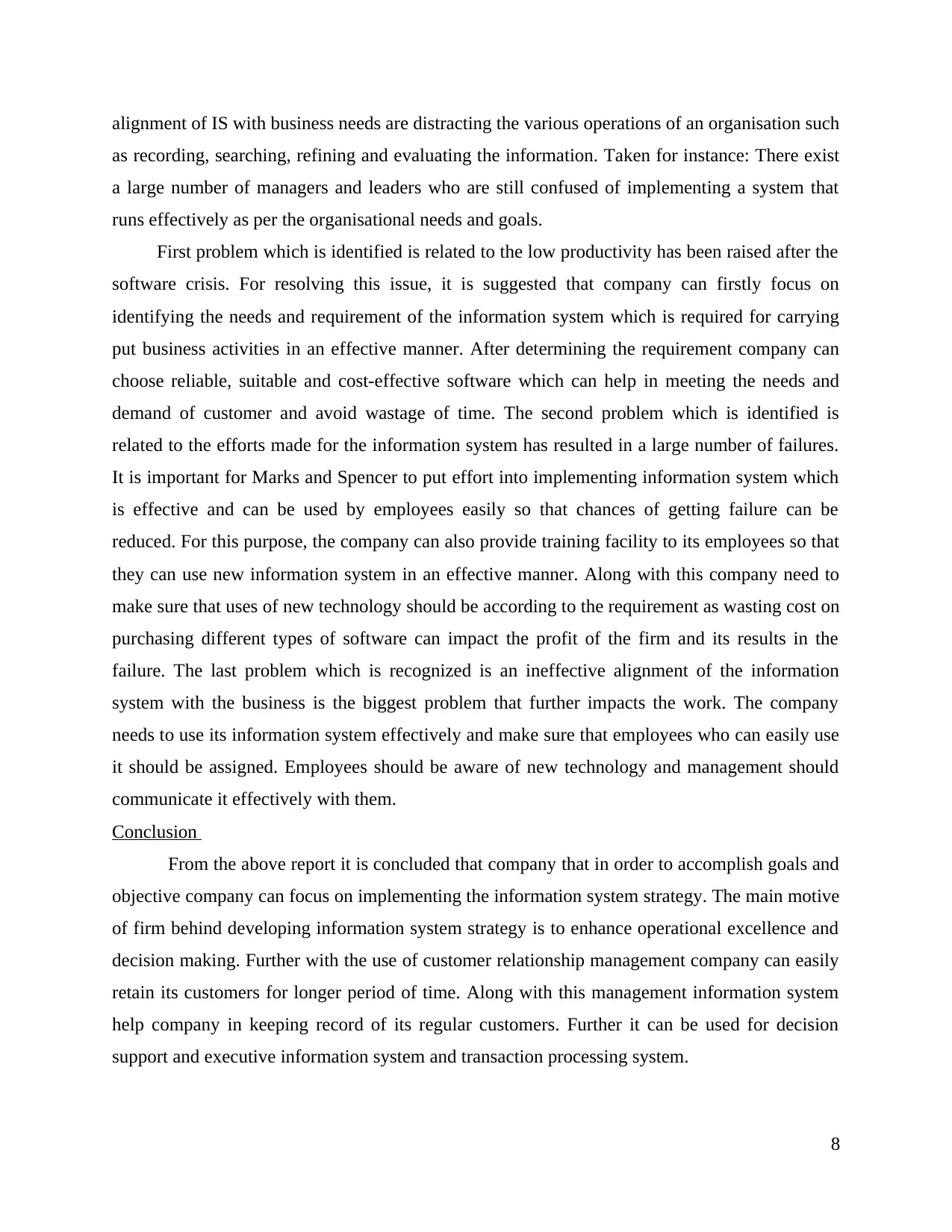
alignment of IS with business needs are distracting the various operations of an organisation such
as recording, searching, refining and evaluating the information. Taken for instance: There exist
a large number of managers and leaders who are still confused of implementing a system that
runs effectively as per the organisational needs and goals.
First problem which is identified is related to the low productivity has been raised after the
software crisis. For resolving this issue, it is suggested that company can firstly focus on
identifying the needs and requirement of the information system which is required for carrying
put business activities in an effective manner. After determining the requirement company can
choose reliable, suitable and cost-effective software which can help in meeting the needs and
demand of customer and avoid wastage of time. The second problem which is identified is
related to the efforts made for the information system has resulted in a large number of failures.
It is important for Marks and Spencer to put effort into implementing information system which
is effective and can be used by employees easily so that chances of getting failure can be
reduced. For this purpose, the company can also provide training facility to its employees so that
they can use new information system in an effective manner. Along with this company need to
make sure that uses of new technology should be according to the requirement as wasting cost on
purchasing different types of software can impact the profit of the firm and its results in the
failure. The last problem which is recognized is an ineffective alignment of the information
system with the business is the biggest problem that further impacts the work. The company
needs to use its information system effectively and make sure that employees who can easily use
it should be assigned. Employees should be aware of new technology and management should
communicate it effectively with them.
Conclusion
From the above report it is concluded that company that in order to accomplish goals and
objective company can focus on implementing the information system strategy. The main motive
of firm behind developing information system strategy is to enhance operational excellence and
decision making. Further with the use of customer relationship management company can easily
retain its customers for longer period of time. Along with this management information system
help company in keeping record of its regular customers. Further it can be used for decision
support and executive information system and transaction processing system.
8
as recording, searching, refining and evaluating the information. Taken for instance: There exist
a large number of managers and leaders who are still confused of implementing a system that
runs effectively as per the organisational needs and goals.
First problem which is identified is related to the low productivity has been raised after the
software crisis. For resolving this issue, it is suggested that company can firstly focus on
identifying the needs and requirement of the information system which is required for carrying
put business activities in an effective manner. After determining the requirement company can
choose reliable, suitable and cost-effective software which can help in meeting the needs and
demand of customer and avoid wastage of time. The second problem which is identified is
related to the efforts made for the information system has resulted in a large number of failures.
It is important for Marks and Spencer to put effort into implementing information system which
is effective and can be used by employees easily so that chances of getting failure can be
reduced. For this purpose, the company can also provide training facility to its employees so that
they can use new information system in an effective manner. Along with this company need to
make sure that uses of new technology should be according to the requirement as wasting cost on
purchasing different types of software can impact the profit of the firm and its results in the
failure. The last problem which is recognized is an ineffective alignment of the information
system with the business is the biggest problem that further impacts the work. The company
needs to use its information system effectively and make sure that employees who can easily use
it should be assigned. Employees should be aware of new technology and management should
communicate it effectively with them.
Conclusion
From the above report it is concluded that company that in order to accomplish goals and
objective company can focus on implementing the information system strategy. The main motive
of firm behind developing information system strategy is to enhance operational excellence and
decision making. Further with the use of customer relationship management company can easily
retain its customers for longer period of time. Along with this management information system
help company in keeping record of its regular customers. Further it can be used for decision
support and executive information system and transaction processing system.
8
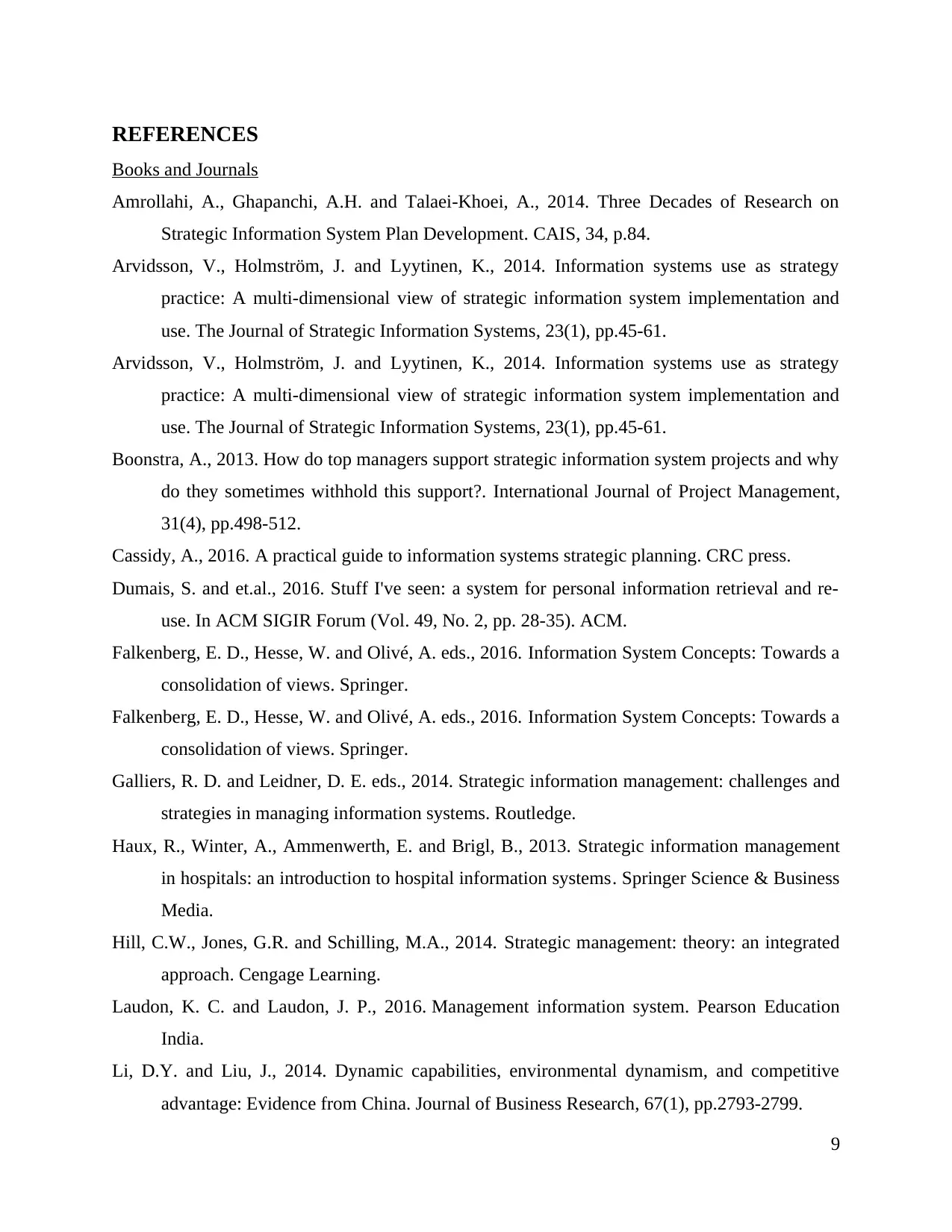
REFERENCES
Books and Journals
Amrollahi, A., Ghapanchi, A.H. and Talaei-Khoei, A., 2014. Three Decades of Research on
Strategic Information System Plan Development. CAIS, 34, p.84.
Arvidsson, V., Holmström, J. and Lyytinen, K., 2014. Information systems use as strategy
practice: A multi-dimensional view of strategic information system implementation and
use. The Journal of Strategic Information Systems, 23(1), pp.45-61.
Arvidsson, V., Holmström, J. and Lyytinen, K., 2014. Information systems use as strategy
practice: A multi-dimensional view of strategic information system implementation and
use. The Journal of Strategic Information Systems, 23(1), pp.45-61.
Boonstra, A., 2013. How do top managers support strategic information system projects and why
do they sometimes withhold this support?. International Journal of Project Management,
31(4), pp.498-512.
Cassidy, A., 2016. A practical guide to information systems strategic planning. CRC press.
Dumais, S. and et.al., 2016. Stuff I've seen: a system for personal information retrieval and re-
use. In ACM SIGIR Forum (Vol. 49, No. 2, pp. 28-35). ACM.
Falkenberg, E. D., Hesse, W. and Olivé, A. eds., 2016. Information System Concepts: Towards a
consolidation of views. Springer.
Falkenberg, E. D., Hesse, W. and Olivé, A. eds., 2016. Information System Concepts: Towards a
consolidation of views. Springer.
Galliers, R. D. and Leidner, D. E. eds., 2014. Strategic information management: challenges and
strategies in managing information systems. Routledge.
Haux, R., Winter, A., Ammenwerth, E. and Brigl, B., 2013. Strategic information management
in hospitals: an introduction to hospital information systems. Springer Science & Business
Media.
Hill, C.W., Jones, G.R. and Schilling, M.A., 2014. Strategic management: theory: an integrated
approach. Cengage Learning.
Laudon, K. C. and Laudon, J. P., 2016. Management information system. Pearson Education
India.
Li, D.Y. and Liu, J., 2014. Dynamic capabilities, environmental dynamism, and competitive
advantage: Evidence from China. Journal of Business Research, 67(1), pp.2793-2799.
9
Books and Journals
Amrollahi, A., Ghapanchi, A.H. and Talaei-Khoei, A., 2014. Three Decades of Research on
Strategic Information System Plan Development. CAIS, 34, p.84.
Arvidsson, V., Holmström, J. and Lyytinen, K., 2014. Information systems use as strategy
practice: A multi-dimensional view of strategic information system implementation and
use. The Journal of Strategic Information Systems, 23(1), pp.45-61.
Arvidsson, V., Holmström, J. and Lyytinen, K., 2014. Information systems use as strategy
practice: A multi-dimensional view of strategic information system implementation and
use. The Journal of Strategic Information Systems, 23(1), pp.45-61.
Boonstra, A., 2013. How do top managers support strategic information system projects and why
do they sometimes withhold this support?. International Journal of Project Management,
31(4), pp.498-512.
Cassidy, A., 2016. A practical guide to information systems strategic planning. CRC press.
Dumais, S. and et.al., 2016. Stuff I've seen: a system for personal information retrieval and re-
use. In ACM SIGIR Forum (Vol. 49, No. 2, pp. 28-35). ACM.
Falkenberg, E. D., Hesse, W. and Olivé, A. eds., 2016. Information System Concepts: Towards a
consolidation of views. Springer.
Falkenberg, E. D., Hesse, W. and Olivé, A. eds., 2016. Information System Concepts: Towards a
consolidation of views. Springer.
Galliers, R. D. and Leidner, D. E. eds., 2014. Strategic information management: challenges and
strategies in managing information systems. Routledge.
Haux, R., Winter, A., Ammenwerth, E. and Brigl, B., 2013. Strategic information management
in hospitals: an introduction to hospital information systems. Springer Science & Business
Media.
Hill, C.W., Jones, G.R. and Schilling, M.A., 2014. Strategic management: theory: an integrated
approach. Cengage Learning.
Laudon, K. C. and Laudon, J. P., 2016. Management information system. Pearson Education
India.
Li, D.Y. and Liu, J., 2014. Dynamic capabilities, environmental dynamism, and competitive
advantage: Evidence from China. Journal of Business Research, 67(1), pp.2793-2799.
9
⊘ This is a preview!⊘
Do you want full access?
Subscribe today to unlock all pages.

Trusted by 1+ million students worldwide
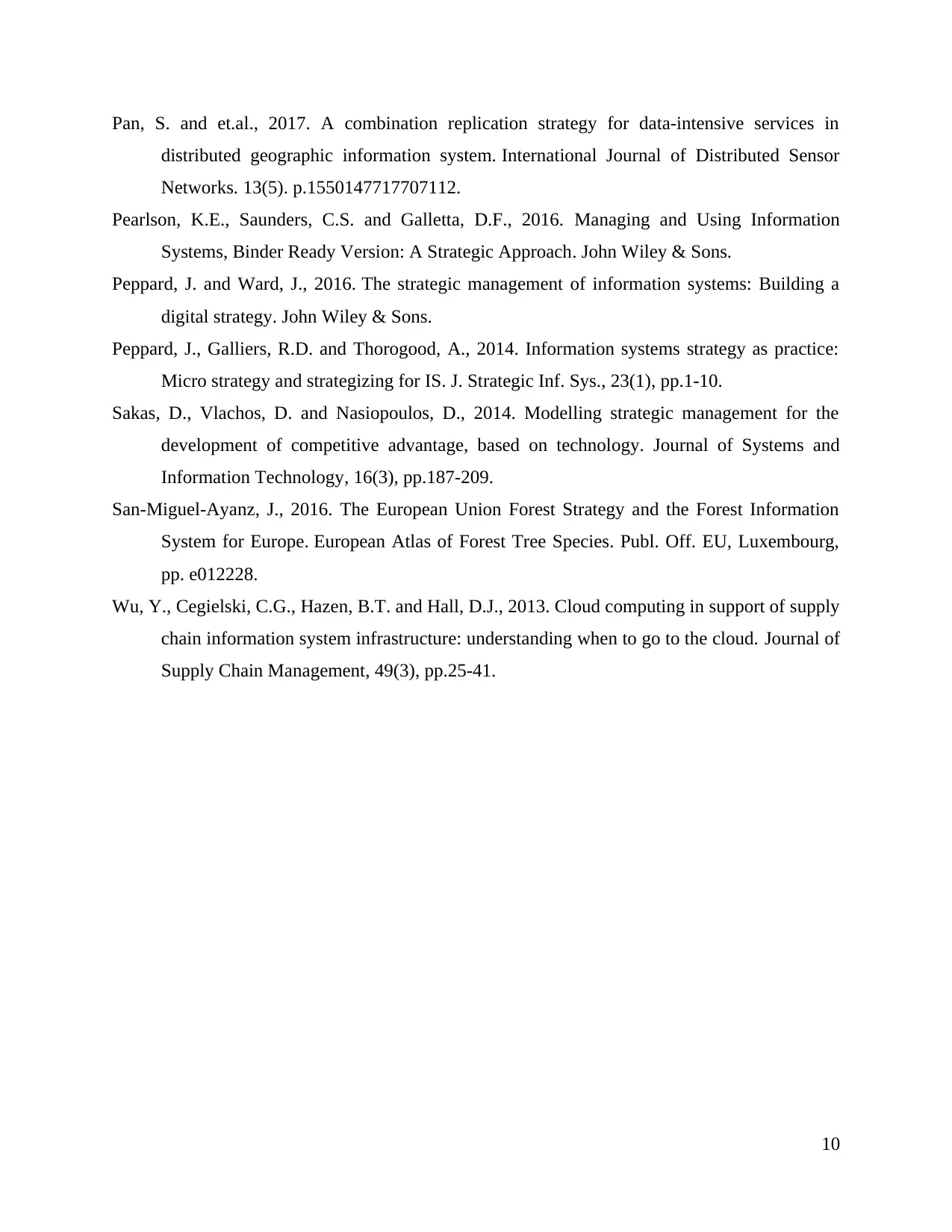
Pan, S. and et.al., 2017. A combination replication strategy for data-intensive services in
distributed geographic information system. International Journal of Distributed Sensor
Networks. 13(5). p.1550147717707112.
Pearlson, K.E., Saunders, C.S. and Galletta, D.F., 2016. Managing and Using Information
Systems, Binder Ready Version: A Strategic Approach. John Wiley & Sons.
Peppard, J. and Ward, J., 2016. The strategic management of information systems: Building a
digital strategy. John Wiley & Sons.
Peppard, J., Galliers, R.D. and Thorogood, A., 2014. Information systems strategy as practice:
Micro strategy and strategizing for IS. J. Strategic Inf. Sys., 23(1), pp.1-10.
Sakas, D., Vlachos, D. and Nasiopoulos, D., 2014. Modelling strategic management for the
development of competitive advantage, based on technology. Journal of Systems and
Information Technology, 16(3), pp.187-209.
San-Miguel-Ayanz, J., 2016. The European Union Forest Strategy and the Forest Information
System for Europe. European Atlas of Forest Tree Species. Publ. Off. EU, Luxembourg,
pp. e012228.
Wu, Y., Cegielski, C.G., Hazen, B.T. and Hall, D.J., 2013. Cloud computing in support of supply
chain information system infrastructure: understanding when to go to the cloud. Journal of
Supply Chain Management, 49(3), pp.25-41.
10
distributed geographic information system. International Journal of Distributed Sensor
Networks. 13(5). p.1550147717707112.
Pearlson, K.E., Saunders, C.S. and Galletta, D.F., 2016. Managing and Using Information
Systems, Binder Ready Version: A Strategic Approach. John Wiley & Sons.
Peppard, J. and Ward, J., 2016. The strategic management of information systems: Building a
digital strategy. John Wiley & Sons.
Peppard, J., Galliers, R.D. and Thorogood, A., 2014. Information systems strategy as practice:
Micro strategy and strategizing for IS. J. Strategic Inf. Sys., 23(1), pp.1-10.
Sakas, D., Vlachos, D. and Nasiopoulos, D., 2014. Modelling strategic management for the
development of competitive advantage, based on technology. Journal of Systems and
Information Technology, 16(3), pp.187-209.
San-Miguel-Ayanz, J., 2016. The European Union Forest Strategy and the Forest Information
System for Europe. European Atlas of Forest Tree Species. Publ. Off. EU, Luxembourg,
pp. e012228.
Wu, Y., Cegielski, C.G., Hazen, B.T. and Hall, D.J., 2013. Cloud computing in support of supply
chain information system infrastructure: understanding when to go to the cloud. Journal of
Supply Chain Management, 49(3), pp.25-41.
10
1 out of 10
Related Documents
Your All-in-One AI-Powered Toolkit for Academic Success.
+13062052269
info@desklib.com
Available 24*7 on WhatsApp / Email
![[object Object]](/_next/static/media/star-bottom.7253800d.svg)
Unlock your academic potential
Copyright © 2020–2025 A2Z Services. All Rights Reserved. Developed and managed by ZUCOL.



